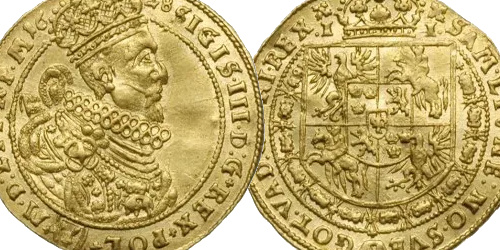An unusual, spectacular rarity whose appearance will surprise many experienced collectors of the Kosciuszko period.
An uncut pair of 5 Kosciuszko zloty together with the back parts, the so-called "heads", which acted as a control coupon.
An item that in this form should not appear on the auction market, as in theory all the heads remain in the collection of the Czapski Museum in Cracow.
It should be noted that this uncut pair includes the two rarest variants of the second series, N.E.2. and N.F.2. with the error ...wszlkich.
Piece of the N.E.2. series printed on a piece of sheet with the full crest filigree element of the paper mill. Only one piece on the entire sheet could have received such a spectacular and representative piece of filigree.An item of unparalleled provenance on the banknote market. This is the only recorded piece in the collector's circulation, coming from the famous 5th WCN auction, where the equally famous Dabrowski collection was sold.
A banknote in PCGS slab with a PCGS grade of 15, where the grade from PCGS in this case should be boldly described as a misunderstanding and treated as an effective security in the collector's trade.
A harsh grade obtained due to tears and old-style spot security in the form of dry understamping, but with this grade of value, the state of preservation goes to a distant side track.
A great rarity, excellent provenance, a high-class curiosity and an excellent addition to the collection of Kościuszko Insurrection banknotes.
We have no doubt that the auction of this item will heat up the auction room to red-hot!
A museum grade object, we definitely recommend it! We can't wait to see it!

format_quoteA pair of insurrection treasury tickets of 5 zloty denomination of the second series together with the so-called backs. Tickets with numbering outside the insurrection range: N.E.2 15387 and N.F.2 15388. The banknotes come from the famous 5th WCN auction (19.11.1993), where Waclaw Dabrowski's collection was auctioned.Treasury tickets at the time of production looked different from those that have survived to the present day in museums, collections or are offered at numismatic auctions. The entire stamp ticket was larger than the pieces issued for circulation, as it still had the so-called "back" (control part). When a sufficient number of treasury tickets were transferred from the General Storehouse to the treasury/insurrectionary coffers, they were cut off from the backs, which were left for later verification of, for example, authenticity or the fact that a given ticket had been issued for circulation.Treasury tickets were printed in pairs on a single sheet of handmade paper from Dutch mills. On a full sheet (plano) with a reproduction of the entire image of the handmade screen and filigree: main and auxiliary, as many as 8 treasury tickets could be accommodated. However, for the purpose of printing the frame (using the woodcut technique) and the main drawing and clause (copperplate), a sheet was divided into 4 smaller ones (quatro) and two treasury tickets were printed on such a divided sheet. Two copperplates with consecutive series (in this case N.E.2 and N.F.2) were used on one plate, numbering them consecutively. Hence, on individual treasury tickets, depending on the place on the sheet on which they were found, we find a fragment of the filigree in the slide, or none at all, and the numbering and its range is not assigned to one letter of the series, but includes all within a given denomination.The production of treasury tickets was divided into stages: inking the paper to the appropriate color for the denomination, printing the frame, applying security marks, numbering and commissioners' signatures. In the final stage, treasury tickets were stamped and bound in so-called seriors of 500 sheets (two or one ticket per page). Only tickets that were fully completed, entered into the records and issued from the General Storehouse (cut from the seriars), where the backs were left for later inspection, were legal tender. In the case of the five-dollar second series, the last recorded ticket issued for circulation was the one with the number 14,900.The pair offered at auction is thus effectively a half-finished product, which did not make it from the place of fabrication to the General Depot from where it could have been issued to the insurgent cashier and released into circulation. Despite the apparent completion of most of the fabrication activities, the tickets were not cut, bound, and did not bear the dry stamps of the Treasury Ticket Directorate. Nor did they reach the General Storehouse. They probably came from the last days before the fall of the uprising, from a batch of unfinished tickets that remained at the place of fabrication. There were at least 490 of them. Similar pairs with numbering from this range are still known. One of them is mentioned in his 1994 study by Marian Kowalski. These are revenue tickets numbered N.C.2 15389 and N.D.2 15390. A great rarityformat_quote












